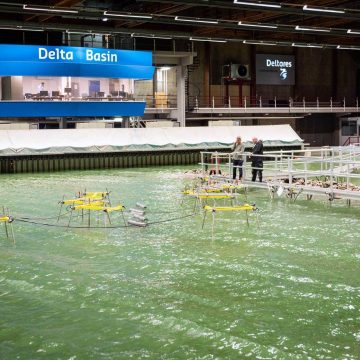Atlantic Basin
The Atlantic Basin is a multifunctional facility designed to simulate waves and tidal currents. Spanning 75 meters in length and 8.7 meters in width, it is ideal for a wide range of applications in offshore, coastal, river, and harbour projects.

The Atlantic Basin, equipped with a wave maker and a pump system, can generate both following and opposing currents, making it ideal for studying wave-current interactions. Its 130 m² test section, filled with compacted non-cohesive sand (d50 about 170 µm), is perfect for scour development tests. The basin's size allows for simultaneous testing of multiple scale models, reducing costs and duration of experiments.
The wave generator, with twenty paddles, can produce any wave and features second-order wave generation and Active Reflection Compensation (ARC) for improved wave quality. With a maximum water depth of around 1 m and a pump capacity of 3000 litres/s, the basin can simulate extreme sea-states representative for locations all around the world at model scales of 35-60. It is equipped with state-of-the-art instrumentation, a gantry crane, and access bridges to ensure high quality test results.
Application areas
The Atlantic Basin is highly relevant for studies that focus on the interaction between waves and currents, hydraulic structures and the seabed. In recent years, the growing offshore wind sector has heavily relied on the Atlantic Basin for numerous projects. We conduct tests for a diverse range of clients, offering them valuable insights and advice leading to substantial optimisations of their designs.
Its realistic simulations of waves interacting with currents, combined with a sandy bed, make it highly suitable for offshore applications. It is regularly used for experiments related to scour development, scour protection performance, cable stabilisation, nature-inclusive designs and wave loads on various structures such as monopiles, jackets, jack-up vessels, gravity-based foundations, and cable crossings.
A notable outcome from this facility for the offshore wind industry is our published journal paper "Predicting loose rock scour protection deformation around monopiles using the relative mobility number and the Keulegan–Carpenter number" and handbook of scour and cable protection methods, containing design guidelines for industry based on a large experimental dataset.
Beyond offshore wind, the Atlantic Basin is used for a variety of coastal, river, harbour, and offshore project. Examples include testing of barriers, energy islands, breakwaters, anchor dragging and floating structures. In 2025, Deltares tested a highly detailed scale model of the Eastern Scheldt storm-surge barrier for Rijkswaterstaat to accurately map the hydrodynamic loads on individual parts of the barrier.
Wave basin
- Length: 75 m
- Width: 8.7 m
- Height: 1.3 m
- Max. water depth : 1.0 m
Wave generation
- Segmented piston-type wave boards
- Maximum significant wave height: 0.25 m
- Maximum wave height: 0.45 m
- Maximum pumping capacity: 3000 l/s
Pumping system
- Max. pumping capacity: 3.0 m3/s
- Current-wave-angle: 0º and 180º
You have not yet indicated whether you want to accept or reject cookies. This means that this element cannot be displayed.
Or go directly to:




